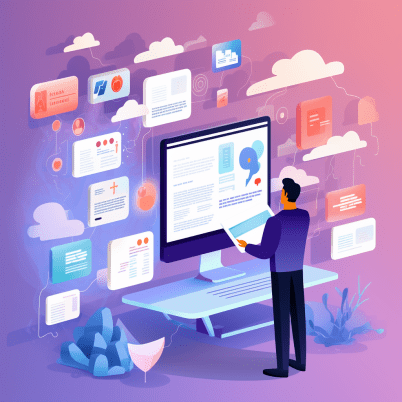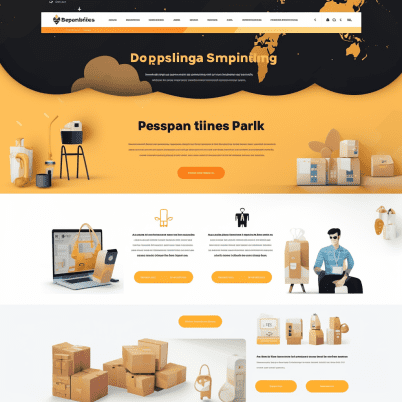In today’s digital age, content marketing has evolved into a fundamental strategy for businesses looking to connect with their target audience and boost sales. As we step into 2023, the landscape of content marketing continues to evolve rapidly, driven by changing consumer behaviors and technological advancements. In this comprehensive guide, we will explore how content marketing is driving sales in 2023 and provide you with actionable insights to help your business thrive in this dynamic environment.

Chapter 1: The Evolution of Content Marketing in 2023
Understanding the How Content Marketing Drives Sales Landscape
To comprehend how content marketing drives sales in 2023, it’s crucial to recognize the current landscape. Content marketing has shifted from being a supplementary strategy to a central pillar of digital marketing. Here’s why:
1.1 Content as the New Currency: In a world overflowing with information, content has become a valuable currency. Consumers seek content that provides value, answers their questions, and entertains them. Brands that can consistently deliver such content establish trust and authority in their niches.
1.2 The Importance of Trust: Trust is more critical than ever. Consumers are wary of blatant advertisements and prefer content that educates and informs. Content marketing allows brands to establish trust by offering valuable insights and solutions.
1.3 Consumer Empowerment: Consumers have access to more information and choices than ever before. They research products and services extensively before making decisions. Content marketing helps businesses meet consumers where they are in their decision-making journey.
1.4 Changing Algorithms: Search engines and social media platforms continually update their algorithms to prioritize high-quality content. This shift emphasizes the need for well-crafted, relevant content that engages audiences.
Trends Shaping Content Marketing in 2023
Content marketing is not static; it evolves with consumer behaviors and technological advancements. Several trends are shaping the content marketing landscape in 2023:
1.5 Interactive Content: Consumers crave engagement. Interactive content like quizzes, polls, and augmented reality experiences are gaining traction as they provide a more immersive user experience.
1.6 Video Dominance: Video content remains a force to be reckoned with. Short-form videos, live streaming, and interactive video experiences are becoming integral to content marketing strategies.
1.7 Voice Search Optimization: With the proliferation of voice-activated devices, optimizing content for voice search is vital. Long-tail keywords and conversational content are in high demand.
1.8 Sustainability and Social Responsibility: Brands are increasingly incorporating sustainability and social responsibility into their content. Consumers align with companies that share their values.
Chapter 2: The Role of High-Quality Content
Creating Valuable and Relevant Content
In 2023, high-quality content is the linchpin of successful content marketing. To drive sales, your content must be valuable, relevant, and engaging. Here’s how to achieve this:
2.1 Thorough Audience Research: Understanding your target audience is paramount. Conduct surveys, analyze customer data, and create detailed buyer personas to tailor your content to their needs and preferences.
2.2 Educational Content: Position your brand as an industry authority by creating educational content that addresses common pain points and questions within your niche.
2.3 Visual Appeal: Visual elements like infographics, images, and videos enhance the user experience. Use them strategically to convey information effectively.
2.4 Consistency: Regularly publish content to keep your audience engaged. Consistency fosters trust and ensures your brand remains top-of-mind.
2.5 Storytelling: Craft compelling narratives that resonate with your audience emotionally. Stories are memorable and can create a lasting connection.
Leveraging Different Types of Content
In 2023, a diverse content strategy is key to capturing a wide audience. Explore various content types:
2.6 Blog Posts: Long-form and well-researched blog posts demonstrate expertise and provide value.
2.7 Videos: Video content is highly shareable and can convey complex information in an engaging manner.
2.8 Infographics: Infographics are visually appealing and simplify complex data.
2.9 Podcasts: Audio content is on the rise, making podcasts an effective way to reach audiences on the go.
2.10 eBooks and Whitepapers: In-depth resources showcase your industry knowledge and can be used as lead magnets.
The Power of Storytelling
Storytelling transcends content formats. It’s about conveying your brand’s narrative and connecting with your audience on a human level. In 2023, storytelling should be at the core of your content marketing strategy:
2.11 Authenticity: Authentic stories resonate with consumers. Share behind-the-scenes glimpses, customer testimonials, and personal anecdotes to humanize your brand.
2.12 Emotional Appeal: Emotions drive action. Craft stories that evoke emotions relevant to your brand and products.
2.13 Consistent Branding: Ensure your storytelling aligns with your brand identity and values. Consistency builds a recognizable brand.
Chapter 3: Personalization and Targeting
Data-Driven Personalization
In 2023, personalization is no longer an option but a necessity. Personalized content significantly influences consumer decisions. Here’s how to implement data-driven personalization:
3.1 Customer Data Collection: Gather data from various touchpoints, including website interactions, email engagement, and social media behavior.
3.2 Customer Segmentation: Divide your audience into segments based on shared characteristics. This allows you to tailor content to specific groups.
3.3 Personalized Recommendations: Use AI algorithms to suggest products or content based on a user’s browsing and purchase history.
3.4 Dynamic Content: Implement dynamic content blocks on your website and emails, displaying different content to different user segments.
Building Customer Personas
Detailed customer personas serve as the foundation for personalized content. In 2023, refine your persona-building process:
3.5 Data-Backed Insights: Base personas on real data rather than assumptions. Analyze customer behavior and preferences to create accurate personas.
3.6 Persona Variability: Recognize that personas can change over time. Regularly update and refine them as your audience evolves.
3.7 Persona Integration: Ensure all teams, from marketing to product development, have access to and understand customer personas.
Using AI and Machine Learning for Targeting
AI and machine learning have transformed content targeting. In 2023, leverage these technologies to enhance your content marketing efforts:
3.8 Predictive Analytics: Predict consumer behavior and preferences using machine learning models. This enables you to create content that anticipates their needs.
3.9 Chatbots and Virtual Assistants: Use AI-powered chatbots to engage with website visitors and provide personalized recommendations in real time.
3.10 Natural Language Processing (NLP): Implement NLP to analyze and understand customer sentiment, allowing you to tailor content accordingly.

Chapter 4: Content Distribution Strategies
SEO in 2023: A Holistic Approach
Search engine optimization (SEO) remains a critical component of content marketing in 2023. However, the approach has evolved. Consider these SEO strategies:
4.1 User Experience (UX): Prioritize UX by optimizing website speed, mobile-friendliness, and navigation. Google rewards websites that provide an excellent user experience.
4.2 Long-Form Content: In-depth, well-researched content ranks higher. Invest in long-form articles and guides.
4.3 Voice Search Optimization: Optimize for voice search by using natural language and answering user questions concisely.
4.4 Schema Markup: Implement schema markup to provide search engines with structured data about your content, improving rich snippets in search results.
The Impact of Social Media
Social media is a content distribution powerhouse in 2023. To drive sales, consider these social media strategies:
4.5 Social Commerce: Platforms like Instagram and Facebook have integrated shopping features. Utilize these to streamline the path from discovery to purchase.
4.6 Influencer Marketing: Partner with influencers in your niche to expand your reach and credibility.
4.7 Stories and Fleets: Leverage ephemeral content on platforms like Instagram and Twitter to create a sense of urgency and FOMO (Fear of Missing Out).
4.8 Social Listening: Monitor social conversations to identify trends and tailor your content accordingly.
Email Marketing Reimagined
Email marketing remains a powerful tool in 2023, but it has evolved beyond generic newsletters. Consider these email marketing strategies:
4.9 Automated Workflows: Implement automated email workflows triggered by user actions, such as abandoned carts or email sign-ups.
4.10 Personalized Email Content: Use dynamic content blocks to tailor emails to individual user preferences.
4.11 AI-Driven Recommendations: Leverage AI algorithms to suggest products or content based on user behavior.
The Rise of Voice and Visual Search
Voice and visual search are changing how consumers discover content and products. In 2023, adapt to these emerging trends:
4.12 Voice Search Optimization: Optimize your content for voice queries by providing concise, conversational answers.
4.13 Visual Search Integration: Implement visual search on your e-commerce platform, allowing users to find products by uploading images.
Chapter 5: User-Generated Content
Harnessing the Power of User Reviews
User-generated content (UGC) can significantly impact sales. In 2023, prioritize UGC in your content marketing strategy:
5.1 Customer Reviews: Encourage customers to leave reviews on your website. Positive reviews build trust and influence purchasing decisions.
5.2 Social Proof: Showcase UGC, such as customer photos and testimonials, to demonstrate the real-world benefits of your products.
5.3 Review Aggregators: Use review aggregators like Trust pilot and Yelp to gather and display reviews from multiple sources.
Encouraging User-Generated Content
Encouraging users to create content for your brand requires a proactive approach:
5.4 Contests and Challenges: Host contests or challenges that encourage customers to create content related to your products or brand.
5.5 Hashtag Campaigns: Create branded hashtags to make it easy for users to tag their content and participate in your campaigns.
5.6 User Stories: Share user stories on your website and social media to showcase the impact of your products on real people.
Building Trust Through Authenticity
Authenticity is a cornerstone of successful UGC campaigns:
5.7 Transparency: Be transparent about how you use user-generated content and always credit creators.
5.8 Respond to Feedback: Engage with users who provide feedback, whether positive or negative. Show that you value their input.
5.9 Consistency: Maintain a consistent brand voice and image in your UGC campaigns to reinforce your identity.
Chapter 6: Content Marketing Metrics in 2023
Moving Beyond Vanity Metrics
In 2023, it’s time to move beyond vanity metrics and focus on actionable data:
6.1 Engagement Metrics: Measure likes, shares, comments, and time spent on your content. These indicate audience interest and engagement.
6.2 Conversion Metrics: Track conversion rates, such as click-through rates (CTR), sign-ups, and purchases directly attributed to your content.
6.3 Customer Lifetime Value (CLV): Understand the long-term value of customers acquired through content marketing efforts.
Measuring Content ROI
Demonstrating the return on investment (ROI) of your content marketing is essential:
6.4 Attribution Modeling: Use attribution models to determine which content touchpoints contribute most to conversions.
6.5 Customer Acquisition Cost (CAC): Calculate the cost of acquiring customers through content marketing efforts and compare it to their lifetime value.
6.6 A/B Testing: Continuously test and optimize your content to improve conversion rates and ROI.
AI and Analytics Tools
AI-powered analytics tools are indispensable in 2023:
6.7 Predictive Analytics: Use AI-driven predictive models to forecast the impact of future content marketing initiatives.
6.8 Sentiment Analysis: Implement sentiment analysis tools to gauge public opinion and adapt your content accordingly.
6.9 Marketing Automation: Invest in marketing automation platforms that integrate with analytics to streamline data-driven decision-making.
Chapter 7: Building a Content Marketing Team
Skills and Roles in 2023
As content marketing grows in complexity, assembling the right team is crucial:
7.1 Content Strategist: Develops the overarching content strategy and aligns it with business goals.
7.2 Content Creators: Writers, designers, videographers, and other content creators produce the actual content.
7.3 SEO Specialists: Optimize content for search engines and monitor SEO performance.
7.4 Data Analysts: Analyze data to measure the effectiveness of content and inform future strategies.
Collaboration and Workflow
Efficient collaboration and workflow are essential for content marketing success:
7.5 Content Calendar: Create a content calendar to plan and schedule content production and distribution.
7.6 Collaboration Tools: Use project management and collaboration tools to streamline communication and tasks within the team.
7.7 Cross-Functional Collaboration: Encourage collaboration between content marketing and other departments, such as sales and product development.
Staying Agile in a Rapidly Changing Landscape
Agility is key to adapting to the ever-changing content marketing landscape:
7.8 Continuous Learning: Invest in ongoing training and development to keep your team up-to-date with the latest trends and technologies.
7.9 Experimentation: Be open to experimentation and testing new content formats and distribution channels.
7.10 Adaptability: Quickly adjust strategies in response to shifts in consumer behavior or market dynamics.
Chapter 8: Content Marketing and E-commerce
Content’s Role in the Customer Journey
Content plays a pivotal role throughout the customer journey:
8.1 Awareness Stage: Attract potential customers through informative blog posts, videos, and social media content.
8.2 Consideration Stage: Provide in-depth content that addresses specific pain points and showcases your expertise.
8.3 Decision Stage: Offer detailed product descriptions, customer reviews, and comparisons to aid the final purchase decision.
Leveraging Content for Product Discovery
In 2023, content marketing can drive product discovery:
8.4 Product Guides: Create guides and tutorials that highlight the features and benefits of your products.
8.5 How-to Content: Offer content that demonstrates how your products can solve common problems or enhance users’ lives.
8.6 Product Launch Campaigns: Build anticipation and excitement for new product launches through storytelling and teasers.
Content-Driven Sales Funnel
Content can guide customers through the sales funnel:
8.7 Lead Generation: Use lead magnets like eBooks and webinars to capture leads interested in your products.
8.8 Nurturing Campaigns: Send targeted content to nurture leads and move them closer to making a purchase.
8.9 Retention: Maintain post-purchase engagement with content like user guides, FAQs, and exclusive offers.

Chapter 9: Case Studies: Successful Content Marketing Campaigns in 2023
Learning from real-world examples is invaluable. In this chapter, we’ll explore case studies of successful content marketing campaigns from various industries. These case studies will provide insights into what works in 2023 and highlight key takeaways that you can apply to your own content marketing efforts.
Chapter 10: The Future of Content Marketing
The content marketing landscape is constantly evolving. In the final chapter, we’ll look ahead to the future of content marketing. We’ll discuss emerging technologies, trends, and strategies that are likely to shape content marketing in the coming years. By staying informed about what’s on the horizon, you can position your business for continued success in the dynamic world of content marketing.
Conclusion
In 2023, content marketing remains a potent force for driving sales and building brand loyalty. The strategies and techniques discussed in this comprehensive guide provide a roadmap for businesses looking to thrive in the ever-changing digital landscape. By adapting to the trends and technologies of the times, investing in high-quality content, and putting the customer at the center of your efforts, you can harness the power of content marketing to drive sales and achieve your business goals in 2023 and beyond.




